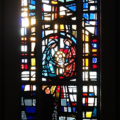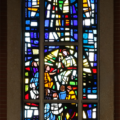Chapel Window 10—The Crucifixion
Welcome to another Windows Wednesday! Today we are looking at Chapel Window 10—The Crucifixion. At the top, we see a cat and a whale, as representations of God’s creation of the animals: the beasts, birds, and creeping things. Below that, we see the focus of this window, Christ on the cross. Jesus, in his triumphant act of mercy, assuming the sins of the world and sacrifices himself for their forgiveness, is shown as the centerpiece of this final full-length window. The faceted glass style lends not only an aesthetic value to this image, but a theological one as well. We see Jesus in quite a bit of detail, from the folds of the fabric to the ribs of his gaunt frame, but he is faceless. All figures in this style are, but in this case, it allows our focus to be on the significance of what he did as opposed to what he looked like. His gaze directs ours downwards to the tableau “Acts of Christian Mercy.” From the Willet description of the scene: “The Christian is feeding and giving drink to someone less fortunate, the open door welcoming the stranger, the garment—clothing the naked, the flowers—visiting the sick, and the manacles and barred window—ransoming the captive. Here is man’s relation to man transformed by the love of God.” It is the Holy Spirit, flowing through all of us, guiding us to be Christ-like in our actions; to put ourselves to work, spreading the love of Christ throughout the world; and to show his mercy to all who are in need of it.
“For we ourselves were once foolish, disobedient, led astray, slaves to various passions and pleasures, passing our days in malice and envy, despicable, hating one another. But when the goodness and loving kindness of God our Savior appeared, he saved us, not because of any works of righteousness that we had done, but according to his mercy, through the water of rebirth and renewal by the Holy Spirit. This Spirit he poured out on us richly through Jesus Christ our Savior, so that, having been justified by his grace, we might become heirs according to the hope of eternal life.” Titus 3:3–7
If you scroll over or click the image of the window below, you will see an original draft of a design for the Crucifixion window from a Willet artist. In this design, the lower third is taken up instead with a scene of student prayer and devotion. This early design is from a set of artwork that had a lower third design for each window, before the tripartite symbolism of Father, Son, and Holy Spirit had been solidified.
[virtual_slide_box id=”9″]


